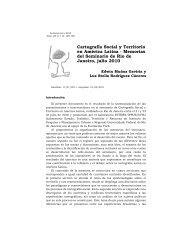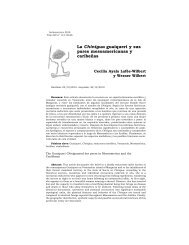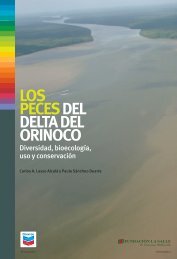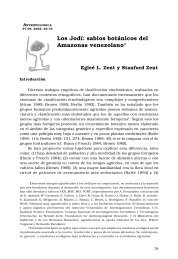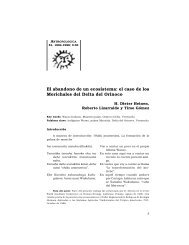War and a Semblance of Peace in the Inca Heartland
War and a Semblance of Peace in the Inca Heartland
War and a Semblance of Peace in the Inca Heartland
Create successful ePaper yourself
Turn your PDF publications into a flip-book with our unique Google optimized e-Paper software.
knowledge. Still, <strong>the</strong>y replied, <strong>and</strong> some replied <strong>in</strong> detail, mention<strong>in</strong>g <strong>the</strong>ir<br />
sources -<strong>of</strong>ten <strong>the</strong>ir fa<strong>the</strong>rs <strong>and</strong> gr<strong>and</strong>fa<strong>the</strong>rs whose names <strong>the</strong>y gave. As<br />
always <strong>in</strong> such <strong>in</strong>stances, some witnesses knew more than o<strong>the</strong>rs, or were<br />
more will<strong>in</strong>g to elaborate <strong>the</strong>ir answers. Although <strong>the</strong> questions were general,<br />
<strong>the</strong> respondents <strong>of</strong>ten seem to reply <strong>in</strong> terms <strong>of</strong> what <strong>the</strong>y knew about <strong>the</strong>ir<br />
own region.<br />
What has made <strong>the</strong>se <strong>in</strong>terviews problematic is that <strong>the</strong>y formed part <strong>of</strong><br />
Viceroy Toledo’s campaign to deny Spanish recognition <strong>of</strong> <strong>the</strong> legitimacy <strong>of</strong><br />
<strong>Inca</strong> rule <strong>and</strong> to underm<strong>in</strong>e <strong>the</strong> structure <strong>of</strong> authority <strong>in</strong> <strong>the</strong> Andes <strong>in</strong><br />
general. 2 Toledo would claim that Spa<strong>in</strong> had wrongly recognized <strong>the</strong> <strong>Inca</strong><br />
dynastic l<strong>in</strong>e as legitimate. They were not natural lords, he argued, but<br />
tyrants. There were no hereditary local lords, ei<strong>the</strong>r, s<strong>in</strong>ce <strong>the</strong> <strong>Inca</strong>s freely<br />
named <strong>and</strong> removed members <strong>of</strong> local l<strong>in</strong>eages to prov<strong>in</strong>cial adm<strong>in</strong>istrative<br />
posts. The k<strong>in</strong>g <strong>of</strong> Spa<strong>in</strong>, <strong>the</strong>n, had a free h<strong>and</strong> <strong>in</strong> reorganiz<strong>in</strong>g <strong>the</strong> structure<br />
<strong>of</strong> authority at all levels (Letter <strong>of</strong> Francisco de Toledo to <strong>the</strong> K<strong>in</strong>g, Cuzco, 1<br />
march 1572; ff. 1-5v). The <strong>in</strong>terviews were conducted by members <strong>of</strong> <strong>the</strong><br />
viceroy’s entourage while he traveled to Cuzco <strong>and</strong> dur<strong>in</strong>g his stay <strong>the</strong>re.<br />
Several, successive questionnaires were adm<strong>in</strong>istered. A read<strong>in</strong>g <strong>of</strong> <strong>the</strong> first<br />
<strong>in</strong>dicates that Toledo <strong>in</strong>itially made an effort to collect real <strong>in</strong>formation from<br />
people who knew someth<strong>in</strong>g (ff. 14v-16). The questions were open-ended, <strong>and</strong><br />
were asked <strong>of</strong> particular <strong>in</strong>dividuals. Later, when Toledo learned what k<strong>in</strong>d <strong>of</strong><br />
responses could be expected, <strong>the</strong> questionnaire was redesigned so that <strong>the</strong><br />
answers only confirmed particular po<strong>in</strong>ts (ff. 48-49v). To <strong>in</strong>crease consensus,<br />
<strong>the</strong> new questionnaire was adm<strong>in</strong>istered to groups <strong>of</strong> witnesses, sometimes as<br />
many as twenty-two. The people <strong>in</strong> each group had diverse orig<strong>in</strong>s, so <strong>the</strong>ir<br />
answers could not be specific to a particular people or place. For <strong>the</strong>se<br />
reasons, <strong>the</strong> answers do not have <strong>the</strong> same value as those elicited <strong>in</strong> <strong>the</strong> first<br />
<strong>in</strong>terviews. A third questionnaire, deal<strong>in</strong>g with “idolatry” <strong>and</strong> “unnatural<br />
practices” was designed <strong>and</strong> adm<strong>in</strong>istered <strong>in</strong> Cuzco (AGI, Patronato 294, no.<br />
6, ff. 1-2v, see note 1); <strong>the</strong> answers <strong>in</strong>clude noth<strong>in</strong>g <strong>of</strong> <strong>in</strong>terest on <strong>the</strong> topic <strong>of</strong><br />
warfare. In addition to <strong>the</strong>se questionnaires, two o<strong>the</strong>r types <strong>of</strong> <strong>in</strong>terviews<br />
were conducted <strong>in</strong> Cuzco. Five Spaniards who had come with Pizarro were<br />
asked what <strong>the</strong>y knew <strong>of</strong> <strong>Inca</strong> rule, based on what <strong>the</strong>y had seen or learned<br />
from native people at <strong>the</strong> time (f. 128). Some <strong>Inca</strong> practices related to warfare<br />
were strange <strong>and</strong> horrify<strong>in</strong>g to Spaniards, so <strong>the</strong> <strong>in</strong>terviews <strong>in</strong>corporate<br />
<strong>in</strong>formation about such th<strong>in</strong>gs. F<strong>in</strong>ally, groups <strong>of</strong> people who had <strong>in</strong>habited<br />
<strong>the</strong> Cuzco valley before <strong>the</strong> <strong>Inca</strong>s arrived were questioned about how <strong>the</strong> <strong>Inca</strong>s<br />
2 An additional problem with <strong>the</strong>m is that one <strong>of</strong> <strong>the</strong> <strong>in</strong>terpreters who participated <strong>in</strong> <strong>the</strong><br />
Informaciones, Gonzalo Gómez Jiménez, was later accused <strong>of</strong> maliciously mis<strong>in</strong>terpret<strong>in</strong>g<br />
testimony (Murra 2002: 434). The accusation was specifically lodged aga<strong>in</strong>st his participation <strong>in</strong><br />
a trial aga<strong>in</strong>st Don Carlos <strong>Inca</strong> <strong>and</strong> o<strong>the</strong>r prom<strong>in</strong>ent <strong>Inca</strong>s <strong>in</strong> 1572, but <strong>the</strong> accusation casts a<br />
shadow over o<strong>the</strong>r proceed<strong>in</strong>gs <strong>in</strong> which he participated as <strong>in</strong>terpreter. In <strong>the</strong> case <strong>of</strong> <strong>the</strong><br />
Informaciones, however, he did not serve as <strong>in</strong>terpreter <strong>in</strong> <strong>the</strong> Jauja <strong>in</strong>terviews, jo<strong>in</strong><strong>in</strong>g <strong>the</strong> Toledo<br />
entourage only after it reached Guamanga.<br />
189



